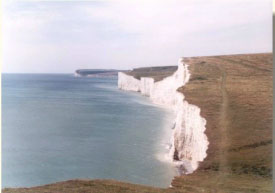SOLID: the lithosphere. Tectonic plates and the movement of the continents, volcanoes, earthquakes, etc. |  |
LIQUID: the hydrosphere. The Earth's water: oceans, seas, rivers and ice. |  |
GAS: the atmosphere. The air we breathe, wind, storms, climate. |  |
Contents of this page: |
Contents of other page: |
This small site briefly introduces the topics of the biosphere and noösphere. I believe these are a way to think about the Internet as a partly biological phenomenon. If that sounds interesting, read on!
However, the site is mainly written to showcase the use of style sheets. You can click here to see the style sheet for this site in a separate browser window that you can refer to as you look at this site. Almost all style information in these two pages has been transferred to the style sheet. (The only exceptions are <I> tags.)
You will find these pages look best in Internet Explorer, but they will appear tolerable on Netscape. This should serve as an illustration of how to try and allow for the differences between the two browsers.
For a long time, the Earth was perceived as an essentially static body. When violent events happened, such as storms, earthquakes or volcanic eruptions, these were the cause of genuine fear, as they were seen as out of kilter with the "perfection" of the planet. Of course, these events can still frighten today but we are now much more aware of their causes. Scientific disciplines such as geology and climatology have shown us that the Earth is not a static place at all - in fact it is highly dynamic.
The rich variety of the Earth's physiology is made up of several intersecting systems, or spheres. Although this is a simplification, there are essentially five of these spheres. The three "physical" spheres broadly correspond to the three states of matter:
SOLID: the lithosphere. Tectonic plates and the movement of the continents, volcanoes, earthquakes, etc. |  |
LIQUID: the hydrosphere. The Earth's water: oceans, seas, rivers and ice. |  |
GAS: the atmosphere. The air we breathe, wind, storms, climate. |  |
Of course it is not always easy to tell where one sphere ends and the others begin. Are clouds liquid, or gas, for instance? What of erosion? But this just goes to show how dynamic the Earth is. Nevertheless, these three spheres are not the end of the story, for alone, they do not include the Earthly phenomenon that is life.
Though the term biosphere was first used by the Austrian geologist Eduard Suess, it was the Russian, Vladimir Vernadsky, who first fully explored it in his 1928 book, The Biosphere (see references). Vernadsky recognised that life on Earth did not just passively inhabit a global environment, but was actively involved in shaping that environment. As with the first three spheres, it is hard to tell where "the environment" ends and "life" begins. There is compelling evidence that, if life had never developed on Earth, it would now be a geologically dead world like Venus or Mars. The mixture of gases in the atmosphere, for instance, is the way it is not by lucky chance but because of billions of years of photosynthesis. Soil is a complex mixture of minerals, nutrients and living organisms like worms. And geological features, like the chalk cliffs of Southern England, are the result of millennia of "construction" by the bodies of microscopic marine organisms.

Life is not just a geological force, it is the prime geological force and, from a distance, can be considered almost as a single phenomenon. Vernadsky recognised that life deserved to be treated as a sphere of the Earth in its own right: the biosphere.
This idea has become more familiar in recent years with James Lovelock's description of Gaia: the Earth as a single "living organism". But Vernadsky would have been rather distressed at Gaia's association with a kind of New Age spirituality (and see also the section on Teilhard de Chardin). He was a hard-nosed scientist who was ahead of his time in recognising that the disciplines of climatology, geology, ecology and others would eventually converge into what is now called "Earth Science". As we learn more about the geological history of our world, we understand more and more that the biosphere is not just scientific speculation, but concrete fact.
Bailes, Kendall E. (1990): Science and Russian Culture in an Age of Revolutions: V. I. Vernadsky and his Scientific School 1863-1945, Bloomington: Indiana University Press.
Lovelock, James E. (1979): Gaia: A New Look at Life on Earth, Oxford: Oxford University Press.
Redfern, Ron (2000): Origins: The Evolution of Continents, Oceans and Life, London: Cassell. (A superbly illustrated and accessible introduction to the interactions between geology and ecology.)
Vernadsky, Vladimir (1998): The Biosphere, trans. D. B. Langmuir, revised and annotated by M. A. S. McMenamin, New York: Copernicus.
Short essay on Gaia, Vernadsky and the "Biosphere 2" experiment
Russian site (in English language) about Vernadsky
Academic paper by this web page's author (requires Adobe Acrobat)
Click here to read the second page
The text and code of this page is © Drew Whitworth 2002. The author asserts his moral rights.